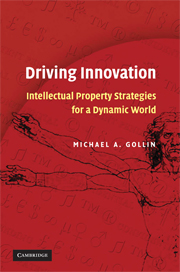Book contents
- Frontmatter
- Contents
- Foreword
- Preface
- Acknowledgments
- Abbreviations
- Introduction: The Invisible Infrastructure of Innovation
- PART I INTELLECTUAL PROPERTY DYNAMICS IN SOCIETY
- PART II BASICS OF MANAGING INTELLECTUAL PROPERTY IN ORGANIZATIONS
- PART III STEPS TO STRATEGIC MANAGEMENT OF INTELLECTUAL PROPERTY
- 8 Becoming Strategic
- 9 Strategy Tools: Policies and Practices for Managing Intellectual Property
- 10 A Menu of Strategy Options
- 11 Evaluating Internal Resources and the External Environment
- 12 Placing a Financial Value on Intellectual Property Assets
- 13 Accessing Innovations of Others
- 14 Acquiring and Policing Intellectual Property Rights
- 15 Doing Innovation Deals
- PART IV STRATEGIES ON A GLOBAL STAGE
- APPENDIX A Excerpts from TRIPS Agreement
- APPENDIX B Intellectual Property Non-Policy
- APPENDIX C Intellectual Property Assessment Questionnaire
- APPENDIX D Research Tools for Obtaining Intellectual Property Information
- Bibliography
- Index
12 - Placing a Financial Value on Intellectual Property Assets
Published online by Cambridge University Press: 05 June 2012
- Frontmatter
- Contents
- Foreword
- Preface
- Acknowledgments
- Abbreviations
- Introduction: The Invisible Infrastructure of Innovation
- PART I INTELLECTUAL PROPERTY DYNAMICS IN SOCIETY
- PART II BASICS OF MANAGING INTELLECTUAL PROPERTY IN ORGANIZATIONS
- PART III STEPS TO STRATEGIC MANAGEMENT OF INTELLECTUAL PROPERTY
- 8 Becoming Strategic
- 9 Strategy Tools: Policies and Practices for Managing Intellectual Property
- 10 A Menu of Strategy Options
- 11 Evaluating Internal Resources and the External Environment
- 12 Placing a Financial Value on Intellectual Property Assets
- 13 Accessing Innovations of Others
- 14 Acquiring and Policing Intellectual Property Rights
- 15 Doing Innovation Deals
- PART IV STRATEGIES ON A GLOBAL STAGE
- APPENDIX A Excerpts from TRIPS Agreement
- APPENDIX B Intellectual Property Non-Policy
- APPENDIX C Intellectual Property Assessment Questionnaire
- APPENDIX D Research Tools for Obtaining Intellectual Property Information
- Bibliography
- Index
Summary
Financial valuation of IP assets is crucial in many circumstances, such as managing an IP portfolio, acquiring IP rights, and calculating prospective damages in an enforcement lawsuit. This chapter presents some threshold questions – the purpose for a valuation, the owner of the assets, and the type of assets – which help when selecting the valuation approach to use. There are four basic approaches, each with strengths and weaknesses in any given situation. First, the cost approach (sunk cost or replacement cost) is perhaps the simplest – how much money did the asset cost to produce, or how much would it cost to replace it. However, cost has little relevance in setting a market value. Second, the income approach focuses on net present value or discounted cash value, and applies only to assets with actual or predictable revenue streams, such as a running royalty. Third, fair market value is determined by reference to comparable assets. Finally, there are hybrid methods, such as rules of thumb for royalty percentages, and approaches for special valuation situations such as converting IP assets into securities. Several techniques can be combined to gain confidence about the value of an IP asset. The financial value of any bundle of IP rights is subject to much debate but ultimately most organizations care about the results, and so IP valuation is an important skill to master for individuals, organizations, and nations.
- Type
- Chapter
- Information
- Driving InnovationIntellectual Property Strategies for a Dynamic World, pp. 207 - 225Publisher: Cambridge University PressPrint publication year: 2008

